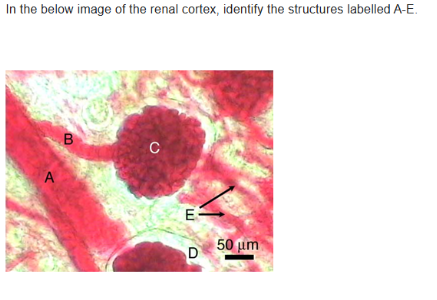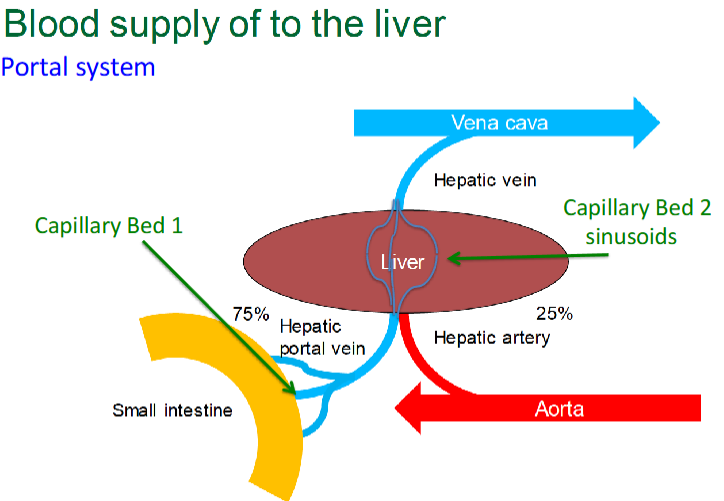SAQ style sample questions
Name the main mechanism through which glucose is transported across the
(i) the apical surface of intestinal epithelium and
(ii) the basolateral surface of the intestinal epithelium
(i) Secondary active transport couple to the sodium gradient via the sodium/glucose (SGLT1) symporter
(ii) facilitated diffusion via GLUT transporter
Name the additional muscle layer that is present in the stomach but is not present in other tubular parts of the GIT. What is the function of this muscle layer?
(Inner) Oblique muscle layer is present in the stomach to faciliate chruning of chyme (mechanical break down of food, mixed with gastric secretions to form a semi-liquid mixture called chyme).
1/32
Earn XP
Description and Tags
From brightspace
Name | Mastery | Learn | Test | Matching | Spaced |
|---|
No study sessions yet.
33 Terms
Name the main mechanism through which glucose is transported across the
(i) the apical surface of intestinal epithelium and
(ii) the basolateral surface of the intestinal epithelium
(i) Secondary active transport couple to the sodium gradient via the sodium/glucose (SGLT1) symporter
(ii) facilitated diffusion via GLUT transporter
Name the additional muscle layer that is present in the stomach but is not present in other tubular parts of the GIT. What is the function of this muscle layer?
(Inner) Oblique muscle layer is present in the stomach to faciliate chruning of chyme (mechanical break down of food, mixed with gastric secretions to form a semi-liquid mixture called chyme).
Name the 3 main surface areas adaptions of the jejunum in order of size starting with the largest.
Plicae circulares (large circular folds of mucosa and submucosa)
Villi (finger-like projections of mucosa)
Microvilli (tiny projections on the apical surface of epithelial cells, forming the brush border)
Name two functions of the respiratory epithelium that lines the trachea
Ciliated cells help waft mucus out of the lungs
Goblet cells produce mucus and secretion that helps moisten the epithelial surface and trap particle matter
Overall the epithelium helps warm, humidify and clean the air.
What effect does themperature have on the function of haemiglobin?
Higher temperature (like excercising muscle) reduce the affinity of haemoglobin for oxygen. This helps unload oxygen in areas of high metabolic activity.
Lower temperature (like in the lungs), the affinity of haemoglobin for oxygen increases. This helps with the uptake of oxygen and release of CO2
Briefly describe how oxygen is transported in the blood?
A small amount of oxygen is transported in the solution
simply dissovled in the blood
majority of oxygen is transported by binding to haemoglobin in red blood cells.
What is the function of the tricuspid valve?
The tricuspid valve function as a one-way valve that closes during ventricular systole to prevent regurgitation of blood from the right ventricle back into the right atrium.
It opens during ventricular diastole, allowing blood to flow from the right atriium into the right ventricle.
List two outcomes of the windkessel function of elastic arteries on arterial blood pressure.
Outcomes include
decreased cardiac oxygen consumption
reduced pulse pressure
maintenance of large positive pressure in the arterial system throughout the cardiac cycle
maintenance of blood flow through the arterial system during diastole.
In one sentence, explain what the vasa vasorum are and their function
The vasa vasorum is a microvascular network that provides blood supply and nourishment for tunica adventitia and outer parts of tunica media of large vessels.
OR
The vasa vasorum are small blood vessels that supply oxygen and nutrients to the walls (tunica adventitia) of large arteries and veins.
Give 2 reasons why capillary hydrostatic pressure (Pcap) decreases only slightly along the length of the glomerular capillaries?
Presence of second set of arterioles after glomerular capillaries i.e. efferent arterioles which offer resistance to the blood flow.
Extensive branching of glomerular capillaries, the increased cross-sectional area results in only minor drop in pressure in glomerular capillaries.

A: Interlobular artery
B: Afferent arteriole
C: Glomerulus
D: Bowman’s space
E: Peritubular capillaries
In a canine expt, a dog’s filtered load of sodium (NA+) in an isolated pump-perfused kidney is found to be 15mmol/min. How much Na+ would predict remains in the tubule at the end of the proximal tubule? Explain your reasoning.
The proximal tubule reabsorbs approx. two-thirds (66%) of the filtered load of sodium (i.e in this case 10mmol/min Na+) suggesting that 5mmol/min of Na+ would remain in the tubule at the end of the proximal tubule.
List the 4 main layers of the oesophagus in order starting at the lumen and moving outwards
Mucosa
Submucosa
Musuclaris externa
Adventitia
What is the correct sequence for these parts of the small intestine (starting at the stomach end and ending at the colon end)
Duodenum
Jejunum
Ileum
The ‘cephalic phase’ of gastric acid production contributes what % of gastric acid production
15%
The epithelium of the oesophagus can be classified as
Stratified, squamous, non-keratinised
Which of the following is NOT a driver of gastric acid production
Somatostain
Which region of the stomach is most associated with stretch in response to eating a meal
Fundus
Located at the corners of the hepatic lobule, what is the name of the blood vessel delivering a large volume (75%) of blood to the liver.
Hepatic portal vein

In which of the following parts of the GIT is material normally stored for the longest period of time
Transverse colon
What is the main cell type of the liver?
Hepatocyte
What is a typical value for the glomerular filtration rate (GFR) in a healthy individual?
125 ml/min
Enteroendocrine cell
specialized cells in the gastrointestinal tract that secrete hormones to regulate digestion and metabolism, such as gastrin, secretin, cholecystokinin, and ghrelin.
Enterocyte
Epithelial cell found in the lining of the small intestine. These cells are primarily responsible for nutrient absorption, including carbohydrates, proteins, fats, vitamins, and minerals, from the digestive tract into the bloodstream. They also play a role in transporting ions and maintaining the intestinal barrier.
Colonocyte
an epithelial cell found in the lining of the colon (large intestine). These cells are primarily responsible for absorbing water and electrolytes from the remaining indigestible food matter, helping to form solid stool. Colonocytes also play a role in maintaining the intestinal barrier and supporting gut health.
Alveolar epithelial cell
cells are found in the lungs' alveoli. Type I cells facilitate gas exchange, while Type II cells produce surfactant to prevent alveolar collapse.
Aldosterone
Hormone that plays a key role in regulating blood pressure and fluid balance.
Azan stain
Blue stain is collagen
Red stain is nuclei
Haematoxylin and Eosin (H&E) stain
Haematoxylin stains nuclei of cells blue/purple
Eosin stains cytoplasm and other tissue components pink/red
What is the function of elasticity?
provides elasticity and flexibility to tissues
What is the function of vasa vasorum?
small blood vessels that supply blood to the walls of larger blood vessels, like arteries and veins.
goblet cells
Epithelial cells that produce and secrete mucus to lubricate and protect the lining of the respiratory, digestive, and other mucous membranes.
Clara (club) cells
Non-ciliated epithelial cells found in the bronchioles. They secrete protective proteins, detoxify harmful substances, and help repair and regenerate the bronchiolar lining.